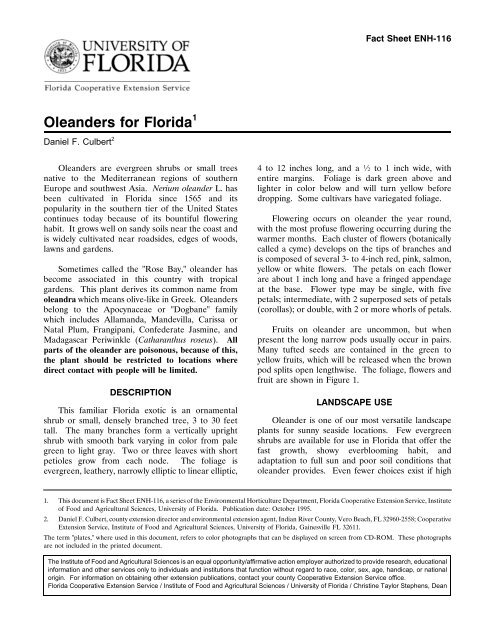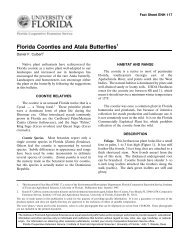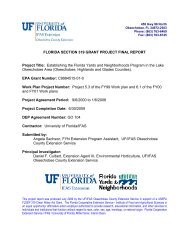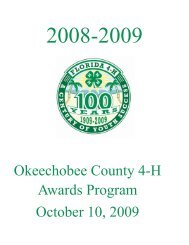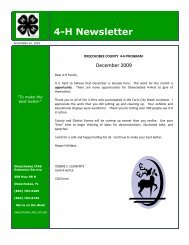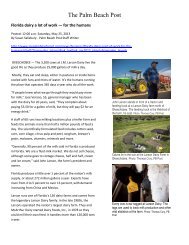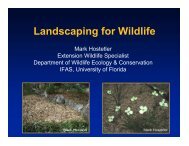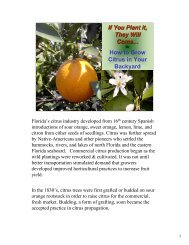Oleanders for Florida - Okeechobee County Extension Service ...
Oleanders for Florida - Okeechobee County Extension Service ...
Oleanders for Florida - Okeechobee County Extension Service ...
Create successful ePaper yourself
Turn your PDF publications into a flip-book with our unique Google optimized e-Paper software.
<strong>Oleanders</strong> <strong>for</strong> <strong>Florida</strong> 1<br />
Daniel F. Culbert 2<br />
<strong>Oleanders</strong> are evergreen shrubs or small trees<br />
native to the Mediterranean regions of southern<br />
Europe and southwest Asia. Nerium oleander L. has<br />
been cultivated in <strong>Florida</strong> since 1565 and its<br />
popularity in the southern tier of the United States<br />
continues today because of its bountiful flowering<br />
habit. It grows well on sandy soils near the coast and<br />
is widely cultivated near roadsides, edges of woods,<br />
lawns and gardens.<br />
Sometimes called the "Rose Bay," oleander has<br />
become associated in this country with tropical<br />
gardens. This plant derives its common name from<br />
oleandra which means olive-like in Greek. <strong>Oleanders</strong><br />
belong to the Apocynaceae or "Dogbane" family<br />
which includes Allamanda, Mandevilla, Carissa or<br />
Natal Plum, Frangipani, Confederate Jasmine, and<br />
Madagascar Periwinkle (Catharanthus roseus). All<br />
parts of the oleander are poisonous, because of this,<br />
the plant should be restricted to locations where<br />
direct contact with people will be limited.<br />
DESCRIPTION<br />
This familiar <strong>Florida</strong> exotic is an ornamental<br />
shrub or small, densely branched tree, 3 to 30 feet<br />
tall. The many branches <strong>for</strong>m a vertically upright<br />
shrub with smooth bark varying in color from pale<br />
green to light gray. Two or three leaves with short<br />
petioles grow from each node. The foliage is<br />
evergreen, leathery, narrowly elliptic to linear elliptic,<br />
Fact Sheet ENH-116<br />
4 to 12 inches long, and a½to1inch wide, with<br />
entire margins. Foliage is dark green above and<br />
lighter in color below and will turn yellow be<strong>for</strong>e<br />
dropping. Some cultivars have variegated foliage.<br />
Flowering occurs on oleander the year round,<br />
with the most profuse flowering occurring during the<br />
warmer months. Each cluster of flowers (botanically<br />
called a cyme) develops on the tips of branches and<br />
is composed of several 3- to 4-inch red, pink, salmon,<br />
yellow or white flowers. The petals on each flower<br />
are about 1 inch long and have a fringed appendage<br />
at the base. Flower type may be single, with five<br />
petals; intermediate, with 2 superposed sets of petals<br />
(corollas); or double, with 2 or more whorls of petals.<br />
Fruits on oleander are uncommon, but when<br />
present the long narrow pods usually occur in pairs.<br />
Many tufted seeds are contained in the green to<br />
yellow fruits, which will be released when the brown<br />
pod splits open lengthwise. The foliage, flowers and<br />
fruit are shown in Figure 1.<br />
LANDSCAPE USE<br />
Oleander is one of our most versatile landscape<br />
plants <strong>for</strong> sunny seaside locations. Few evergreen<br />
shrubs are available <strong>for</strong> use in <strong>Florida</strong> that offer the<br />
fast growth, showy everblooming habit, and<br />
adaptation to full sun and poor soil conditions that<br />
oleander provides. Even fewer choices exist if high<br />
1. This document is Fact Sheet ENH-116, a series of the Environmental Horticulture Department, <strong>Florida</strong> Cooperative <strong>Extension</strong> <strong>Service</strong>, Institute<br />
of Food and Agricultural Sciences, University of <strong>Florida</strong>. Publication date: October 1995.<br />
2. Daniel F. Culbert, county extension director and environmental extension agent, Indian River <strong>County</strong>, Vero Beach, FL 32960-2558; Cooperative<br />
<strong>Extension</strong> <strong>Service</strong>, Institute of Food and Agricultural Sciences, University of <strong>Florida</strong>, Gainesville FL 32611.<br />
The term "plates," where used in this document, refers to color photographs that can be displayed on screen from CD-ROM. These photographs<br />
are not included in the printed document.<br />
The Institute of Food and Agricultural Sciences is an equal opportunity/affirmative action employer authorized to provide research, educational<br />
in<strong>for</strong>mation and other services only to individuals and institutions that function without regard to race, color, sex, age, handicap, or national<br />
origin. For in<strong>for</strong>mation on obtaining other extension publications, contact your county Cooperative <strong>Extension</strong> <strong>Service</strong> office.<br />
<strong>Florida</strong> Cooperative <strong>Extension</strong> <strong>Service</strong> / Institute of Food and Agricultural Sciences / University of <strong>Florida</strong> / Christine Taylor Stephens, Dean
<strong>Oleanders</strong> <strong>for</strong> <strong>Florida</strong> Page 2<br />
tolerance to drought and salt are important.<br />
Figure 1. Foliage, Flower and Fruit of Oleander.<br />
Selection and hybridization have resulted in cultivars<br />
of various plant size, different flower colors and<br />
shapes, and longer bloom persistence.<br />
<strong>Oleanders</strong> are available <strong>for</strong> use as small<br />
"standard" trees, shrubs, ground covers, large fencing<br />
or screening shrubs, and as potted patio plants.<br />
Dwarf <strong>for</strong>ms are available as large ground covers or<br />
container plants providing vivid, summer-flowering<br />
interest. For best results and minimum maintenance,<br />
be sure to choose a cultivar whose growth<br />
characteristics and ultimate size fit your intended<br />
landscape use. Table 1 lists common cultivars used in<br />
<strong>Florida</strong>.<br />
GENERAL CULTURE<br />
Oleander is adapted to climatic conditions<br />
throughout <strong>Florida</strong>. However, this plant may<br />
experience injury in cold weather. In northern and<br />
western <strong>Florida</strong>, it should be used where it can be<br />
protected from freezing conditions. While it is highly<br />
salt tolerant, it does not do well when directly<br />
exposed to salt spray. Plant it behind the dune lines<br />
<strong>for</strong> best results.<br />
Full sun is necessary <strong>for</strong> best flowering and <strong>for</strong><br />
development of a full, fountain-shaped crown. In<br />
shade, it will grow lanky and produce few flowers.<br />
Oleander is tolerant of a wide range of soil types and<br />
grows well in sandy dry areas. It is adaptable to a pH<br />
range of 5.0 to more than 8.3.<br />
Oleander transplants easily. For best results,<br />
plant container-grown oleanders during early<br />
summer when in active growth. Plants should be<br />
mulched to a depth of 3 inches.<br />
Newly planted oleanders should be irrigated<br />
regularly <strong>for</strong> the first few months to aid in<br />
establishment. Standards or larger specimens with<br />
stem diameters greater than 1-inch benefit from<br />
regular irrigation <strong>for</strong> one year. Oleander is very<br />
drought tolerant once established, but moist soils or<br />
irrigation stimulate growth.<br />
Oleander has low fertility requirements.<br />
Established plants usually do not need fertilizer<br />
because root systems extend into lawns where they<br />
can absorb nutrients from turf fertilizers. Growth of<br />
small plants may be stimulated with up to 3<br />
applications per year of a complete fertilizer. Use a<br />
rate of 1 pound nitrogen per 1000 square feet applied<br />
to the area within 1½ to 2 times the canopy diameter.<br />
Organic sources of nutrients and slow-release<br />
inorganic fertilizers will provide <strong>for</strong> longer periods of<br />
fertilizer availability.<br />
Pruning<br />
Young oleanders characteristically develop<br />
multiple stems. If a plant is to be grown as a<br />
"standard," the smallest stems should be removed<br />
leaving one main stem <strong>for</strong> a single-trunk specimen.<br />
<strong>Oleanders</strong> generally require some pruning <strong>for</strong> best<br />
flowering. "Suckers" or water sprouts may develop<br />
along the lower portions of main stems or from roots.<br />
Excessive suckering, especially with young plants, will<br />
inhibit flowering. Tip pruning to remove old flower<br />
clusters will increase the number of blooming tips.<br />
Dwarf cultivars occasionally grow tall shoots that<br />
must be removed to maintain the planting as a<br />
ground cover. Shoots of some dwarf and miniature<br />
cultivars occasionally die to the ground, and this dead<br />
wood should be removed when noticed.
<strong>Oleanders</strong> <strong>for</strong> <strong>Florida</strong> Page 3<br />
Figure 2. Rejuvenation pruning <strong>for</strong> oleanders: A) First year, B) Second year, C) Third year, D) Result<br />
If severe pruning is necessary to improve plant<br />
shape or <strong>for</strong>m, prune oleanders anytime after the rate<br />
of flowering has fallen. <strong>Oleanders</strong> are often pruned<br />
hard on an annual or regular basis. Such severe<br />
pruning can induce excess vegetative growth, basal<br />
sprouting, and fewer, but larger, flower clusters.<br />
Generally, the natural clumping type shape is<br />
preferred in hedges and screen plantings. Removal of<br />
one-third of the older stems or canes in successive<br />
pruning over three years is preferred to a complete<br />
cutting back of the plant to ground level. This is<br />
called rejuvenation pruning, as illustrated in Figure 2.<br />
Here are the steps:<br />
A) First year: Remove one-third of old mature<br />
stems near ground level.<br />
B) Second year: Remove one-half of the<br />
remaining old stems and head back long new<br />
shoots from last year’s growth.<br />
C) Third year: Remove the remaining old stems<br />
and head back the long new shoots.<br />
D) The desired Result will be apparent at the end<br />
of the third year of growth.<br />
The time to prune may be dictated by personal<br />
preference, but avoid late fall or winter pruning which<br />
encourages frost sensitive new growth.<br />
Pests<br />
<strong>Oleanders</strong> can be one of the most pest-free<br />
landscape plants with proper placement and pest<br />
monitoring. Primary pests are the oleander<br />
caterpillar, oleander scale, and occasionally aphids.<br />
Witches’ broom is a serious plant disease of oleander.<br />
Bacterial gall and mushroom root rot are other plant<br />
diseases that may be encountered. For current<br />
pesticide recommendations, please contact your<br />
county’s Cooperative <strong>Extension</strong> <strong>Service</strong>.<br />
The Oleander caterpillar (Plate 1) is the most<br />
significant insect pest of oleanders. The caterpillar is<br />
an immature (larval) phase of the Oleander Moth,<br />
Syntomeida epilais jucundissima. The adult female<br />
moth lays clusters of 25 to 75 orange eggs under<br />
leaves. Young larva will skeletonize the leaves, while<br />
the more mature, orange-colored caterpillar with<br />
black spots and hairs will eat the entire blade. By<br />
biting the veins, the caterpillar drains the toxic sap<br />
be<strong>for</strong>e consuming the leaf.<br />
When it reaches a mature size of about 2 inches<br />
long, the insect pupates. The silk-covered cocoon<br />
yields a purple-black winged moth that has several<br />
white dots on the wings. With a sixty-day life cycle,<br />
this pest can have three generations in a year.<br />
Scouting <strong>for</strong> the eggs and young caterpillars in March,<br />
July and December will enable control measures to<br />
reduce feeding damage. Bacillus thuringensis<br />
insecticides can provide environmentally safe yet<br />
effective control. Chemical insecticides also can be<br />
used.<br />
Oleander scale, Aspidiotus nerii, are common on<br />
many plants in our subtropical area. These small (1-2<br />
mm) whitish insects are found on either the top or<br />
bottom surface of the leaf, and are round in shape.<br />
Their hard, armored shell makes them difficult to<br />
control. Other scales that may be found on<br />
oleander include the black, dictyospermun, false<br />
oleander (Plate 2), <strong>Florida</strong> wax (Plate 3),<br />
hemispherical (Plate 4), nigra, and plumose scales.<br />
Other sucking insects affecting oleander may<br />
include the Oleander aphid, Aphis nerii, and the<br />
Longtailed Mealybug, Pseudococcus longispinus (Plate<br />
5). Aphids are yellow, soft-bodied insects which<br />
damage oleanders by inserting mouthparts into soft<br />
tissue and extracting plant sap. Aphids can reproduce<br />
rapidly. Heavy infestations distort leaves and stunt<br />
new growth.
<strong>Oleanders</strong> <strong>for</strong> <strong>Florida</strong> Page 4<br />
One or more insect population peaks may occur<br />
at any time between May and September. Although<br />
many predatory insects feed on aphids, they usually<br />
cannot control the aphids. Regular scouting, removal<br />
of branches with high levels of infestation, and sprays<br />
of insecticidal soaps or horticultural oils are the most<br />
environmentally safe pesticides. Persistent problems<br />
may indicate a need <strong>for</strong> chemical insecticides.<br />
During feeding, aphids secrete droplets of a<br />
sugary solution called "honeydew." Drops of<br />
honeydew fall from the aphids onto leaves and stems<br />
below. This sugary solution promotes the growth of<br />
sooty mold fungi (Plate 6), Capnodium species. Sooty<br />
mold appears as a black staining or powdery coating<br />
on leaves and stems. The blackened leaves and stems<br />
are often the most obvious sign of aphid infestation.<br />
Although unsightly, sooty mold itself does not<br />
directly harm oleanders. However, the black fungus<br />
shades the leaves and reduces photosynthesis,<br />
potentially effecting the long-term vigor of the plant.<br />
Control of sucking insects will halt further<br />
development of sooty mold. Existing sooty mold on<br />
leaves will wear off through the actions of sun, rain<br />
and wind. Sprays of insecticidal soaps and<br />
horticultural oils <strong>for</strong> control of aphids and scales also<br />
help to loosen and remove sooty mold.<br />
Witches’ Broom is the most serious plant disease<br />
of oleanders. It is caused by a fungus, Sphaeropsis<br />
tumefaciens, which causes tip die back and the<br />
<strong>for</strong>mation of a tight cluster of shoots from below the<br />
affected area. These shoots will grow only a few<br />
inches, turn brown and die. Infectious symptoms can<br />
appear in two to fifteen weeks after the infection<br />
occurs, and seem to be more common during cooler<br />
months. The fungus can be spread by wind, insects,<br />
or by infected pruning tools.<br />
No chemical fungicides are available to control<br />
witches’ broom, and no oleander cultivars are known<br />
to be resistant to this affliction. Affected stems<br />
should be pruned back at least 6 inches into<br />
unaffected wood. Look at the cut end of the stem to<br />
see if any discoloration from the systemic fungal<br />
growth is present, and prune back further if this is<br />
noticed. To prevent infection of unaffected plant<br />
parts, dip pruning tools in rubbing alcohol be<strong>for</strong>e<br />
using them on another branch or plant.<br />
Bacterial Gall is a plant disease occasionally seen<br />
as wart-like growths on oleanders. Spongy growths on<br />
leaves and longitudinal swellings on the stems result<br />
from the bacteria Pseudomonas syringae tonelliana<br />
entering wounds caused by insects or other agents.<br />
As with witches’ broom, prune out affected parts and<br />
sterilize pruning tools.<br />
Another plant disease of oleanders that is<br />
sometimes encountered is Mushroom Root Rot, which<br />
may be caused by the fungus Armillaria mellea or<br />
other fungal organisms. The plant appears to wilt<br />
because the crown areas have been damaged by the<br />
fungus, preventing the movement of moisture into the<br />
tops of the plant. Wet soil conditions encourage the<br />
fungus. Avoid over-watering and limit the use of<br />
heavy clay or muck soils; excessive mulching which<br />
covers up the crown also should be avoided.<br />
Propagation<br />
Oleander can be propagated vegetatively by<br />
softwood, semi-hardwood, or tip cuttings. Cuttings<br />
root easily when taken in early summer. Use of<br />
rooting hormone improves rooting percentages. Tip<br />
or air layers also may be taken to propagate<br />
oleanders. Because of the ease of vegetative<br />
propagation, use of seed to grow new oleanders can<br />
not be recommended except <strong>for</strong> plant breeders.<br />
Cultivars<br />
Many cultivars of oleanders have been selected<br />
and developed by private individuals, nurseries and<br />
public institutions. A tentative checklist of oleander<br />
cultivars lists 401 entries; of these about 175 are said<br />
to be currently available <strong>for</strong> horticultural use.<br />
Selected oleander cultivars are listed and described in<br />
Table 1.<br />
TOXICITY<br />
According to the American Medical Association<br />
Handbook on Poisonous and Injurious Plants, all parts<br />
of the oleander plant contain two toxic principles.<br />
These toxic principles, oleandroside and nerioside,<br />
both have been identified as glycosides. This<br />
extremely toxic plant can poison livestock and humans<br />
at any time of the year. Lethal doses of leaves <strong>for</strong><br />
livestock have been established <strong>for</strong> horses (15-30<br />
grams), cows (10-25 grams), and sheep (1-5 grams).<br />
Many people in the landscape industry have spent<br />
years working with oleander without experiencing<br />
oleander poisoning from landscape workers or from<br />
plants in the landscape. A 1961 report exists of<br />
flamingos being killed by oleander poisoning. There
<strong>Oleanders</strong> <strong>for</strong> <strong>Florida</strong> Page 5<br />
are also reports that children in India died from<br />
eating the flowers and a report from <strong>Florida</strong> that<br />
persons using oleander sticks to cook hot dogs were<br />
poisoned.<br />
Symptoms<br />
Action of the poisons in oleander is similar to the<br />
action of the heart drug known as digitalis. The usual<br />
symptoms are severe gastroenteritis, diarrhea,<br />
abdominal pain, sweating and weakness. These signs<br />
appear within a few hours after eating the leaves.<br />
Cardiac irregularities are common, often<br />
characterized by increased heart rate. However, a<br />
slower heart rate is often detected in the later stages.<br />
Symptomatic treatment is suggested but is usually<br />
unsuccessful. Contact a physician, hospital, or poison<br />
control center if ingestion is suspected.<br />
Precautions with Oleander<br />
Because of its poisonous nature, the placement of<br />
this plant in a landscape should be carefully<br />
considered. The best use of this plant may be in<br />
areas where people will not come in direct contact<br />
with it. Parents should avoid planting oleander in<br />
their home landscape where there is a potential <strong>for</strong><br />
small children to consume parts of this plant. When<br />
disposing of branches pruned from oleanders, do not<br />
burn the branches: the volatile oils that make the<br />
plant poisonous will become airborne and may cause<br />
respiratory difficulties if the smoke is inhaled. Pet<br />
owners and livestock producers also are cautioned to<br />
place this plant out of the reach of animals who may<br />
graze on it.<br />
It is not recommended that oleanders be<br />
eliminated from all <strong>Florida</strong> landscapes. To do so<br />
would limit our choices of colorful flowering shrubs<br />
that thrive in adverse environmental conditions with<br />
minimal care. A better approach is to educate<br />
persons, workers and residents to treat them with<br />
respect and to place them where the danger of<br />
poisoning will be limited.<br />
REFERENCES<br />
Atilano, R.A. "Screening Oleander Cultivars <strong>for</strong><br />
Resistance to Witches’ Broom." Proceedings of<br />
the <strong>Florida</strong> State Horticultural Society 94<br />
(1981):218-219.<br />
Broschat, Timothy K. & Meerow, Alan W. Betrock’s<br />
Reference Guide to <strong>Florida</strong> Landscape Plants.<br />
Cooper City, FL: Betrock Publishing Co., 1991.<br />
Gilman, Edward F. & Watson, Dennis G. "Nerium<br />
Oleander - Oleander" (Fact Sheet ST-412).<br />
Gainesville: <strong>Florida</strong> Cooperative <strong>Extension</strong><br />
<strong>Service</strong>, March 1994.<br />
Graf, Alfred B. Exotica 4. East Ruther<strong>for</strong>d: Roehrs<br />
Company, 1985.<br />
Johnson, Warren T. & Lyon, Howard H. Insects that<br />
Feed on Trees and Shrubs. 2nd ed. Ithaca:<br />
Cornell University Press, 1991.<br />
Lampe, K.F. & McCann, M. 1985. AMA Handbook<br />
of Poisonous and Injurious Plants. Chicago:<br />
American Medical Association. Distributed by<br />
Chicago Review Press.<br />
Pagen, F.J.J. <strong>Oleanders</strong> - Nerium L. and the Oleander<br />
Cultivars. Netherlands: Agricultural University<br />
Wageningen, 1988.<br />
Rose, Sylvester. "Nerium oleander." Gainesville:<br />
<strong>Florida</strong> Cooperative <strong>Extension</strong> <strong>Service</strong>, undated.<br />
Sander<strong>for</strong>d, Mark V. Acoustic Courtship<br />
Communication of the Polka Dot Wasp Moth,<br />
Syntomeida epilas Walker. Winston-Salem, NC:<br />
Wake Forest University, PhD Dissertation, May<br />
1992.<br />
Smith, Michael D., ed. The Ortho Problem Solver.<br />
2nd ed., 521-523. San Francisco: Ortho<br />
In<strong>for</strong>mation <strong>Service</strong>s, 1984.<br />
Watkins, John V. & Sheehan, Thomas J. <strong>Florida</strong><br />
Landscape Plants. Gainesville: University Presses<br />
of <strong>Florida</strong>, 1975.<br />
West, Erdman. "Poisonous Plants Around the Home"<br />
(Bulletin 175D). Gainesville: <strong>Florida</strong> Cooperative<br />
<strong>Extension</strong> <strong>Service</strong>, November 1993.
<strong>Oleanders</strong> <strong>for</strong> <strong>Florida</strong> Page 6<br />
Table 1. Characteristics of Selected Nerium oleander Cultivars.<br />
Size Group and Cultivar Flower Color Flower Type Origin Comments<br />
DWARF (mature height 3-5 feet)<br />
Petite Salmon orangish-pink single 1973 Los<br />
Angeles<br />
Arboretum<br />
Petite Pink pink --- 1973 Los<br />
Angeles<br />
Arboretum<br />
Sister Agnes or Soeur Agnés white, cream<br />
throat<br />
TALL (mature height 10-25 feet or more)<br />
may be hedged to 3 feet;<br />
will grow to 6 feet, tightly<br />
branched.<br />
well suited <strong>for</strong> residential<br />
landscapes<br />
single 1868 France hardy, fragrant, large<br />
flowers, favored in<br />
Cali<strong>for</strong>nia because spent<br />
blooms readily drop<br />
Atropurpureum dark purple-red single 1835 Belgium hardy, large blooms<br />
Calypso deep pink single 1975 <strong>Florida</strong> very hardy and vigorous,<br />
good blooming<br />
Carneum Plenum or Mrs.<br />
Roeding<br />
Comfe Berthelemy or<br />
Commandant Berthelemy<br />
salmon-pink double 1854 Germany somewhat weaker growth,<br />
persistent blooms slightly<br />
weeping growth habit<br />
red and pink<br />
with yellow<br />
margins<br />
superposed corollas 1898 France large flower<br />
Common dark pink to red single 79 A.D.<br />
Mediterranean<br />
an unimproved natural<br />
variety, unscented<br />
Hardy Red bright red single 1965 large flowers and<br />
inflorescences<br />
Isle of Capri light yellow single 1963 tender<br />
Pink Hawaii salmon pink,<br />
yellow throat<br />
single 1965 vigorous growth; an<br />
introduction used at Disney<br />
World<br />
Roseum rose pink single 1872 Italy profuse flowering, vigorous<br />
Variegatum pink single 1822 France vigorous; narrow gray green<br />
foliage with marginal<br />
variegation.<br />
Variegatum plenum pink with rose<br />
throat<br />
double 1978 Dark green foliage with<br />
marginal variegation<br />
White white single 1874 ---


